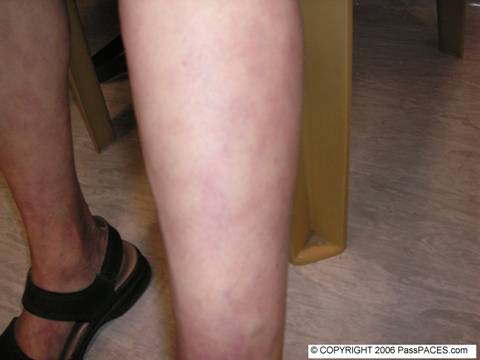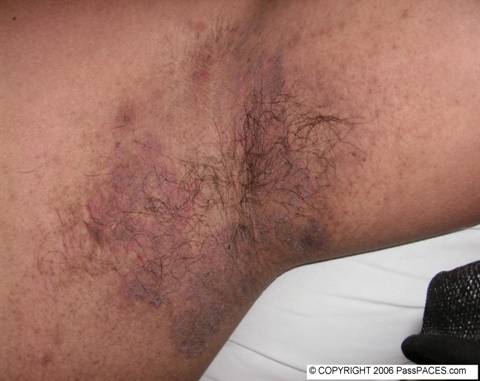
|
|
|||||
|
|
|
|
|
|
|
 |
|
|||
| Your latest issue for MRCP PACES is here! |
Look at this lady lower limbs.

Discussion:
It is an uncommon case in MRCP, however, it is worthwhile to learn about this.
If you look carefully at her lower limbs, you actually notice this lady has a reticular pigmented rash. There are two
common scenarios in PACES that give reticular pigmented rash. These two conditions are erythema ab igne and livedo reticularis. It can be quite difficult to differentiate these two conditions, however, erythema ab igne usually appear to be more dusky and
besides over the lower limbs, you can find it on the abdomen. It is uncommon to find erythema ab igne in tropical countries,
therefore, you shouldn't be too worried if you are going to sit your MRCP in Singapore, Dubai or Malaysia. The reason is simple
because it is associated with repeated exposure to heat especially in the elderly who sit in front of open fireplaces.You seldom
need to sit in front of fireplaces to get heat in these countries because of the weather. Look for
signs of hypothyroidism and tell the examiners you would look for underlying malignancy such as intra-abdominal malignancy or
chronic pancreatitis. Whereas in livedo reticularis, it is associated with SLE and usually found in young females.If you find
livedo reticularis, always look for other signs to suggest SLE and also tell examiners that you would look for underlying malignancy as
well.
Common questions examiners would ask you,
- Can livedo reticularis be normal? ( Yes, because it can be found in young females especially in cold weather)
- What other conditions are associated with livedo reticularis? ( Besides SLE, other conditions include polyarteritis nodosa, occult malignancy and microemboli of skin)
Conclusion:
This lady has livedo reticularis due to SLE
Extra points:
- Although it is not a popular question, livedo reticularis is often missed by candidates in SLE patients during their exam. If you are dealing with a SLE patient, skin conditions that are associated with SLE are hyperpigmentation, discoid rash, malar rash, livedo reticularis, alopecia, purpura, telangiectasia and vasculitic rash.
- If you find erythema ab igne in patient's lower limbs, always look at the abdomen as well!
| Case ID: 2 | Created: 13 June 2006 |
Look at this gentleman skin.

Discussion:
This is a commoner question as compared to Q1 in MRCP exams. Yes, you are right, it is acanthosis nigricans! It is always described as 'black, velvety overgrowth in the skin' by books. Always tell the examiners you would look at other sites for this especially over the neck ( a very common site other than axilla, especially at the back of the neck), umbilicus, nipples, groins and facial skin. Also suggest to examiners that you would,
- check the urine for glycouria ( because patient may have insulin resistance)
- check for occult malignancy especially adenocarcinoma of stomach
- ask for menses irregularity if the patient is female because it is associated with polycystic ovarian syndrome
Common questions examiners would ask you,
1) What conditions are associated with acanthosis nigricans?
2) How do you define metabolic syndrome?
Conclusion:
This gentleman has acanthosis nigricans and diabetes mellitus.
Extra points,
- Remember criteria to diagnose metabolic syndrome either based on NCEP or WHO criteria.
- Remember 1 or 2 examples of cutaneous manifestations of viceral malignancy such as dermatomyositis and Paget's disease of the nipple.
To see previous issues, click here! To send a quick comment, use our shoutbox, click here!